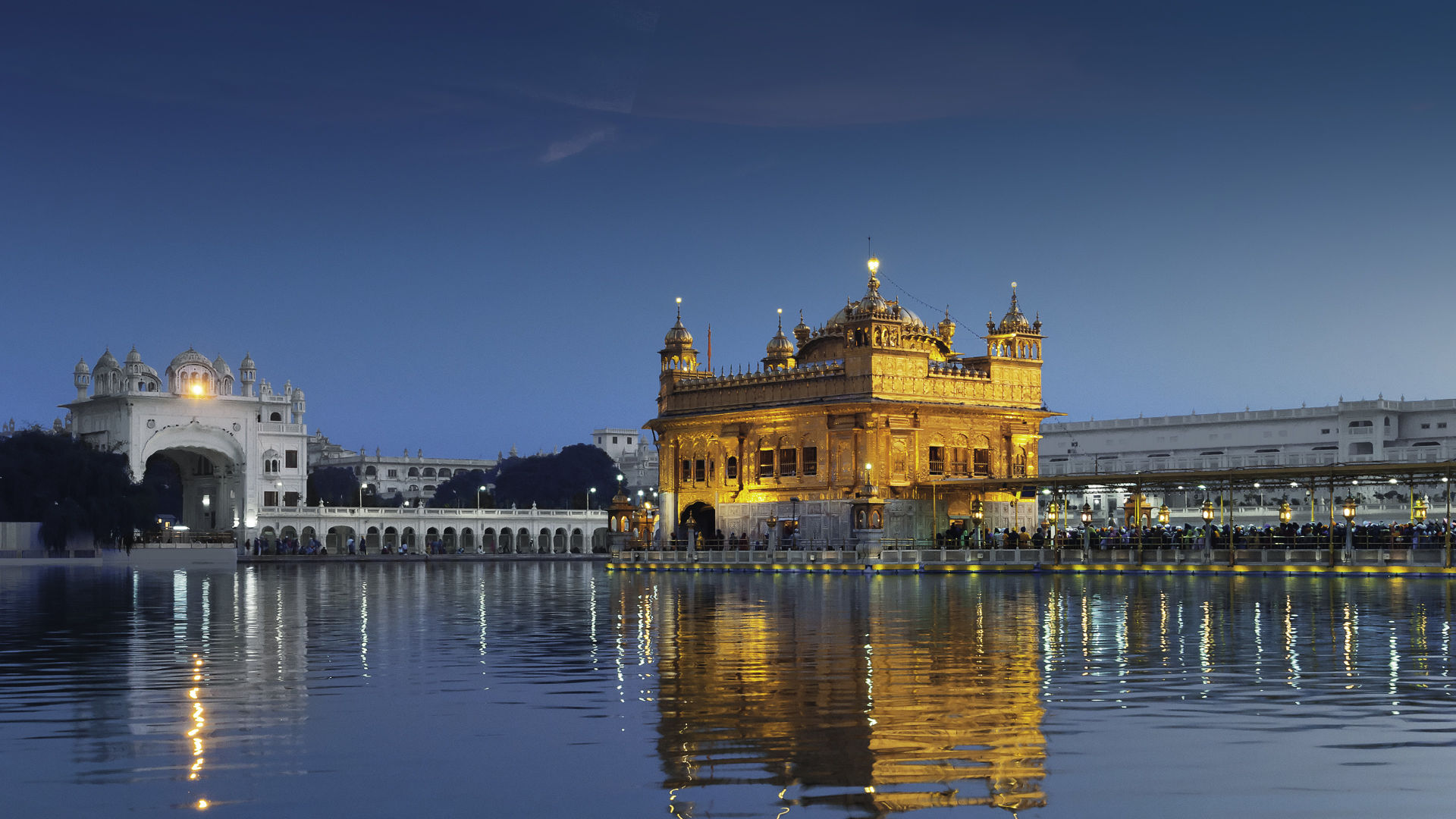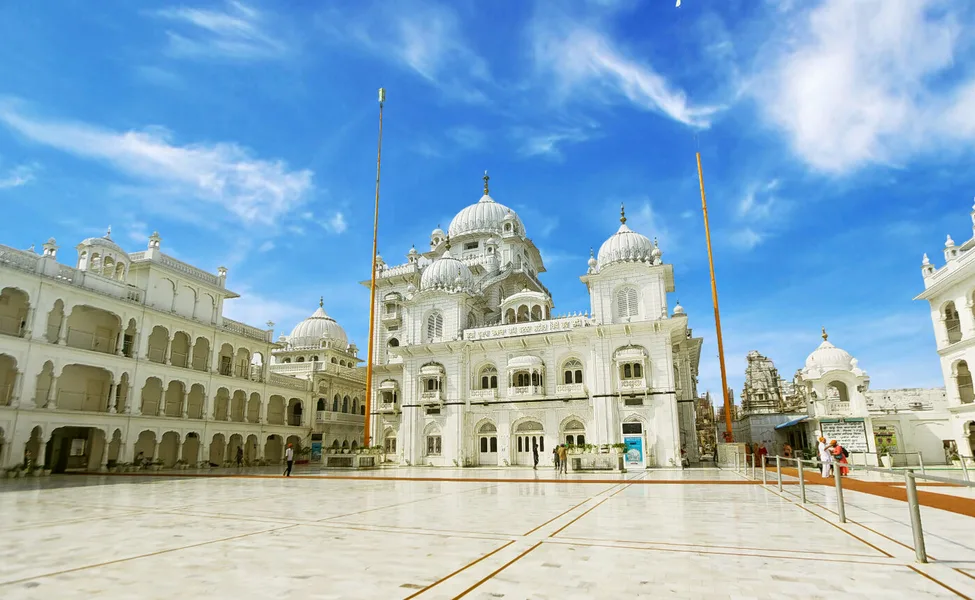Hukamnama | Sri Darbar Sahib | Hukamnama Sri Darbar Sahib Today |
ਸੱਚਖੰਡ ਸ੍ਰੀ ਹਰਿਮੰਦਰ ਸਾਹਿਬ ਸ੍ਰੀ ਅੰਮ੍ਰਿਤਸਰ ਸਾਹਿਬ ਜੀ ਤੋਂ ਅੱਜ ਦਾ ਅੰਮ੍ਰਿਤ ਵੇਲੇ ਦਾ ਮੁੱਖਵਾਕ
ਅੰਗ :- 508
ਗੂਜਰੀ ਕੀ ਵਾਰ ਮਹਲਾ ੩ ਸਿਕੰਦਰ ਬਿਰਾਹਿਮ ਕੀ ਵਾਰ ਕੀ ਧੁਨੀ ਗਾਉਣੀ
ੴ ਸਤਿਗੁਰ ਪ੍ਰਸਾਦਿ ॥
ਸਲੋਕੁ ਮਃ ੩ ॥
ਇਹੁ ਜਗਤੁ ਮਮਤਾ ਮੁਆ ਜੀਵਣ ਕੀ ਬਿਧਿ ਨਾਹਿ ॥ ਗੁਰ ਕੈ ਭਾਣੈ ਜੋ ਚਲੈ ਤਾਂ ਜੀਵਣ ਪਦਵੀ ਪਾਹਿ ॥ ਓਇ ਸਦਾ ਸਦਾ ਜਨ ਜੀਵਤੇ ਜੋ ਹਰਿ ਚਰਣੀ ਚਿਤੁ ਲਾਹਿ ॥ ਨਾਨਕ ਨਦਰੀ ਮਨਿ ਵਸੈ ਗੁਰਮੁਖਿ ਸਹਜਿ ਸਮਾਹਿ ॥ ਮਃ ੩ ॥ ਅੰਦਰਿ ਸਹਸਾ ਦੁਖੁ ਹੈ ਆਪੈ ਸਿਰਿ ਧੰਧੈ ਮਾਰ ॥ ਦੂਜੈ ਭਾਇ ਸੁਤੇ ਕਬਹਿ ਨ ਜਾਗਹਿ ਮਾਇਆ ਮੋਹ ਪਿਆਰ ॥ ਨਾਮੁ ਨ ਚੇਤਹਿ ਸਬਦੁ ਨ ਵੀਚਾਰਹਿ ਇਹੁ ਮਨਮੁਖ ਕਾ ਆਚਾਰੁ ॥ ਹਰਿ ਨਾਮੁ ਨ ਪਾਇਆ ਜਨਮੁ ਬਿਰਥਾ ਗਵਾਇਆ ਨਾਨਕ ਜਮੁ ਮਾਰਿ ਕਰੇ ਖੁਆਰ ॥੨॥ ਪਉੜੀ ॥ ਆਪਣਾ ਆਪੁ ਉਪਾਇਓਨੁ ਤਦਹੁ ਹੋਰੁ ਨ ਕੋਈ ॥ ਮਤਾ ਮਸੂਰਤਿ ਆਪਿ ਕਰੇ ਜੋ ਕਰੇ ਸੁ ਹੋਈ ॥ ਤਦਹੁ ਆਕਾਸੁ ਨ ਪਾਤਾਲੁ ਹੈ ਨਾ ਤ੍ਰੈ ਲੋਈ ॥ ਤਦਹੁ ਆਪੇ ਆਪਿ ਨਿਰੰਕਾਰੁ ਹੈ ਨਾ ਓਪਤਿ ਹੋਈ ॥ ਜਿਉ ਤਿਸੁ ਭਾਵੈ ਤਿਵੈ ਕਰੇ ਤਿਸੁ ਬਿਨੁ ਅਵਰੁ ਨ ਕੋਈ ॥੧॥
ਅਰਥ: ਇਹ ਜਗਤ (ਭਾਵ, ਹਰੇਕ ਜੀਵ) (ਇਹ ਚੀਜ਼ ‘ਮੇਰੀ’ ਬਣ ਜਾਏ, ਇਹ ਚੀਜ਼ ‘ਮੇਰੀ’ ਹੋ ਜਾਏ— ਇਸ) ਅਣਪੱਤ ਵਿਚ ਇਤਨਾ ਫਸਿਆ ਪਿਆ ਹੈ ਕਿ ਇਸ ਨੂੰ ਜੀਉਣ ਦੀ ਜਾਚ ਨਹੀਂ ਰਹੀ ।ਜੋ ਜੋ ਮਨੁੱਖ ਸਤਿਗੁਰੂ ਦੇ ਕਹੇ ਤੇ ਤੁਰਦਾ ਹੈ ਉਹ ਜੀਵਨ-ਜੁਗਤਿ ਸਿੱਖ ਲੈਂਦੇ ਹਨ,ਜੋ ਮਨੁੱਖ ਪ੍ਰਭੂ ਦੇ ਚਰਨਾਂ ਵਿਚ ਚਿੱਤ ਜੋੜਦੇ ਹਨ, ਉਹ ਸਮਝੋ, ਸਦਾ ਹੀ ਜੀਉਂਦੇ ਹਨ,(ਕਿਉਂਕਿ) ਹੇ ਨਾਨਕ ਜੀ! ਗੁਰੂ ਦੇ ਸਨਮੁਖ ਹੋਇਆਂ ਮਿਹਰ ਦਾ ਮਾਲਕ ਪ੍ਰਭੂ ਮਨ ਵਿਚ ਆ ਵੱਸਦਾ ਹੈ ਤੇ ਗੁਰਮੁਖਿ ਉਸ ਅਵਸਥਾ ਵਿਚ ਜਾ ਅੱਪੜਦੇ ਹਨ ਜਿਥੇ ਪਦਾਰਥਾਂ ਵਲ ਮਨ ਡੋਲਦਾ ਨਹੀਂ ।੧।ਮਃ ੩ ॥ਉਹਨਾਂ ਦੇ ਮਨ ਵਿਚ ਤੌਖਲਾ ਤੇ ਕਲੇਸ਼ ਟਿਕਿਆ ਰਹਿੰਦਾ ਹੈ, ਉਹਨਾਂ ਨੇ ਦੁਨੀਆ ਦੇ ਝੰਬੇਲਿਆਂ ਦਾ ਇਹ ਖਪਾਣਾ ਆਪਣੇ ਸਿਰ ਉਤੇ ਆਪ ਸਹੇੜਿਆ ਹੋਇਆ ਹੈ,ਜਿਨ੍ਹਾਂ ਮਨੁੱਖਾਂ ਦਾ ਮਾਇਆ ਨਾਲ ਮੋਹ ਪਿਆਰ ਹੈ ਜੋ ਮਾਇਆ ਦੇ ਪਿਆਰ ਵਿਚ ਮਸਤ ਹੋ ਰਹੇ ਹਨ (ਇਸ ਗ਼ਫ਼ਲਿਤ ਵਿਚੋਂ) ਕਦੇ ਜਾਗਦੇ ਨਹੀਂ ।ਆਪਣੇ ਮਨ ਦੇ ਪਿੱਛੇ ਤੁਰਨ ਵਾਲੇ ਬੰਦਿਆਂ ਦੀ ਰਹਿਣੀ ਇਹ ਹੈ ਕਿ ਉਹ ਕਦੇ ਗੁਰ-ਸ਼ਬਦ ਨਹੀਂ ਵੀਚਾਰਦੇ ।ਹੇ ਨਾਨਕ ਜੀ! ਉਹਨਾਂ ਨੂੰ ਪਰਮਾਤਮਾ ਦਾ ਨਾਮ ਨਸੀਬ ਨਹੀਂ ਹੋਇਆ, ਉਹ ਜਨਮ ਅਜਾਈਂ ਗਵਾਂਦੇ ਹਨ ਤੇ ਜਮ ਉਹਨਾਂ ਨੂੰ ਮਾਰ ਕੇ ਖ਼ੁਆਰ ਕਰਦਾ ਹੈ (ਭਾਵ, ਮੌਤ ਹੱਥੋਂ ਸਦਾ ਸਹਮੇ ਰਹਿੰਦੇ ਹਨ) ।੨। ਪਉੜੀ ॥ਜਦੋਂ ਪ੍ਰਭੂ ਨੇ ਆਪਣਾ ਆਪ (ਹੀ) ਪੈਦਾ ਕੀਤਾ ਹੋਇਆ ਸੀ ਤਦੋਂ ਕੋਈ ਹੋਰ ਦੂਜਾ ਨਹੀਂ ਸੀ,ਸਲਾਹ ਮਸ਼ਵਰਾ ਭੀ ਆਪ ਹੀ ਕਰਦਾ ਸੀ, ਜੋ ਕਰਦਾ ਸੀ ਸੋ ਹੁੰਦਾ ਸੀ ।ਉਸ ਵੇਲੇ ਨਾਹ ਆਕਾਸ਼ ਨਾਹ ਪਾਤਾਲ ਤੇ ਨਾਹ ਇਹ ਤ੍ਰੈਵੇ ਲੋਕ ਸਨ,ਕੋਈ ਉਤਪੱਤੀ ਅਜੇ ਨਹੀਂ ਸੀ ਹੋਈ, ਆਕਾਰ-ਰਹਿਤ ਪਰਮਾਤਮਾ ਅਜੇ ਆਪ ਹੀ ਆਪ ਸੀ ।ਜੋ ਪ੍ਰਭੂ ਨੂੰ ਭਾਉਂਦਾ ਹੈ ਉਹੀ ਕਰਦਾ ਹੈ ਉਸ ਤੋਂ ਬਿਨਾ ਹੋਰ ਕੋਈ ਨਹੀਂ ਹੈ ।੧।
गूजरी की वार महला ३ सिकंदर बिराहिम की वार की धुनी गाउणी
ੴ सतिगुर प्रसादि ॥
सलोकु मः ३ ॥
इहु जगतु ममता मुआ जीवण की बिधि नाहि ॥गुर कै भाणै जो चलै तां जीवण पदवी पाहि ॥ओइ सदा सदा जन जीवते जो हरि चरणी चितु लाहि ॥नानक नदरी मनि वसै गुरमुखि सहजि समाहि ॥१॥मः ३ ॥अंदरि सहसा दुखु है आपै सिरि धंधै मार ॥दूजै भाइ सुते कबहि न जागहि माइआ मोह पिआर ॥नामु न चेतहि सबदु न वीचारहि इहु मनमुख का आचारु ॥हरि नामु न पाइआ जनमु बिरथा गवाइआ नानक जमु मारि करे खुआर ॥२॥पउड़ी ॥आपणा आपु उपाइओनु तदहु होरु न कोई ॥मता मसूरति आपि करे जो करे सु होई ॥तदहु आकासु न पातालु है ना त्रै लोई ॥तदहु आपे आपि निरंकारु है ना ओपति होई ॥जिउ तिसु भावै तिवै करे तिसु बिनु अवरु न कोई ॥१॥
अर्थ: ये जगत (भाव, हरेक जीव) (ये चीज ‘मेरी’ बन जाए, ये चीज ‘मेरी’ हो जाए- इस) अपनत्व में इतना फसा पड़ा है कि इसे जीने की विधि नहीं रही। जो जो मनुष्य सतिगुरु के कहने पर चलता है वह जीवन-जुगति सीख लेता है। जो मनुष्य प्रभु के चरणों में चित्त जोड़ता है, वह समझो सदा ही जीते हैं, (क्योंकि) हे नानक! गुरु के सन्मुख रहने से मेहर का मालिक प्रभु मन में आ बसता है और गुरमुखि उस अवस्था में आ पहुँचते हैं जहाँ पदार्थों की ओर मन नहीं डोलता।1। जिस मनुष्यों का माया से मोह-प्यार है जो माया के प्यार में मस्त हो रहे हैं (इस गफ़लत में से) कभी जागते नहीं, उनके मन में संशय और कष्ट टिका रहता है, उन्होंने दुनिया के झमेलों का ये खपाना अपने सिर पर लिया हुआ है। अपने मन के पीछे चलने वाले लोगों की रहन-सहन ये है कि वे कभी गुर-शब्द नहीं विचारते। हे नानक! उन्हें परमात्मा का नाम नसीब नहीं हुआ, वह जनम व्यर्थ गवाते हैं और जम उन्हें मार के ख्वार करता है (भाव, वे मौत से सदा सहमे रहते हैं)।2। जब प्रभु ने अपना आप (ही) पैदा किया हुआ था तब कोई और दूसरा नहीं था, सलाह-मश्वरा भी खुद ही करता था, जो करता था वह होता था। उस वक्त ना आकाश ना पाताल और ना ही ये तीनों लोक थे, कोई उत्पत्ति अभी नहीं हुई थी, आकार-रहित परमात्मा अभी खुद ही खुद था। जो प्रभु को भाता है वही करता है उसके बिना और कोई नहीं है।1।
Goojaree Kee Vaar Mehalaa 3
Sikandhar Biraahim Kee Vaar Kee Dhhunee Gaaounee
Ik Oankaar Sathigur Prasaadh ||
Salok Ma 3 ||
Eihu Jagath Mamathaa Muaa Jeevan Kee Bidhh Naahi || Gur Kai Bhaanai Jo Chalai Thaan Jeevan Padhavee Paahi || Oue Sadhaa Sadhaa Jan Jeevathae Jo Har Charanee Chith Laahi || Naanak Nadharee Man Vasai Guramukh Sehaj Samaahi ||1|| Ma 3 || Andhar Sehasaa Dhukh Hai Aapai Sir Dhhandhhai Maar || Dhoojai Bhaae Suthae Kabehi N Jaagehi Maaeiaa Moh Piaar || Naam N Chaethehi Sabadh N Veechaarehi Eihu Manamukh Kaa Aachaar || Har Naam N Paaeiaa Janam Birathhaa Gavaaeiaa Naanak Jam Maar Karae Khuaar ||2|| Pourree || Aapanaa Aap Oupaaeioun Thadhahu Hor N Koee || Mathaa Masoorath Aap Karae Jo Karae S Hoee || Thadhahu Aakaas N Paathaal Hai Naa Thrai Loee || Thadhahu Aapae Aap Nirankaar Hai Naa Oupath Hoee || Jio This Bhaavai Thivai Karae This Bin Avar N Koee ||1||
Meaning: This world perishing in attachment and possessiveness; no one knows the way of life.One who walks in harmony with the Guru’s Will, obtains the supreme status of life.Those humble beings who focus their consciousness on the Lord’s Feet, live forever and ever.O Nanak Ji, by His Grace, the Lord abides in the minds of the Gurmukhs, who merge in celestial bliss. ||1||Third Mehl:Within the self is the pain of doubt; engrossed in worldly affairs, they are killing themselves.Asleep in the love of duality, they never wake up; they are in love with, and attached to Maya.They do not think of the Naam, the Name of the Lord, and they do not contemplate the Word of the Shabad. This is the conduct of the self-willed manmukhs.They do not obtain the Lord’s Name, and they waste away their lives in vain; O Nanak Ji, the Messenger of Death punishes and dishonors them. ||2||Pauree:He created Himself – at that time, there was no other.He consulted Himself for advice, and what He did came to pass.At that time, there were no Akaashic Ethers, no nether regions, nor the three worlds.At that time, only the Formless Lord Himself existed – there was no creation.As it pleased Him, so did He act; without Him, there was no other. ||1||
www.shrimuktsarsahib.in
hukamnama,
hukamnama from amritsar today,
hukamnama sri darbar sahib today,
hukamnama sahib,
hukamnama katha manji sahib today,
hukamnama darbar sahib,
hukamnama from amritsar today with meaning,
hukamnama today,
hukamnama from amritsar today live,
hukamnama sri darbar sahib today live,
hukamnama darbar sahib today,
hukamnama from amritsar today evening,
hukamnama amritsar,
hukamnama amritsar today,
hukamnama aaj ka,
hukamnama ajj da,
hukamnama amritsar darbar sahib,
hukamnama ang 621,
hukamnama ardas,
hukamnama app,
hukamnama ang 725,
hukamnama amritsar sahib,
aaj da hukamnama,
aj da hukamnama golden temple in punjabi,
aaj ka hukamnama,
ajj da hukamnama darbar sahib amritsar,
aj da hukamnama,
aaj da hukamnama harmandir sahib,
aaj da hukamnama sri harmandir sahib,
aaj da hukamnama amritsar,
amritsar hukamnama,
aaj ka hukamnama darbar sahib,



